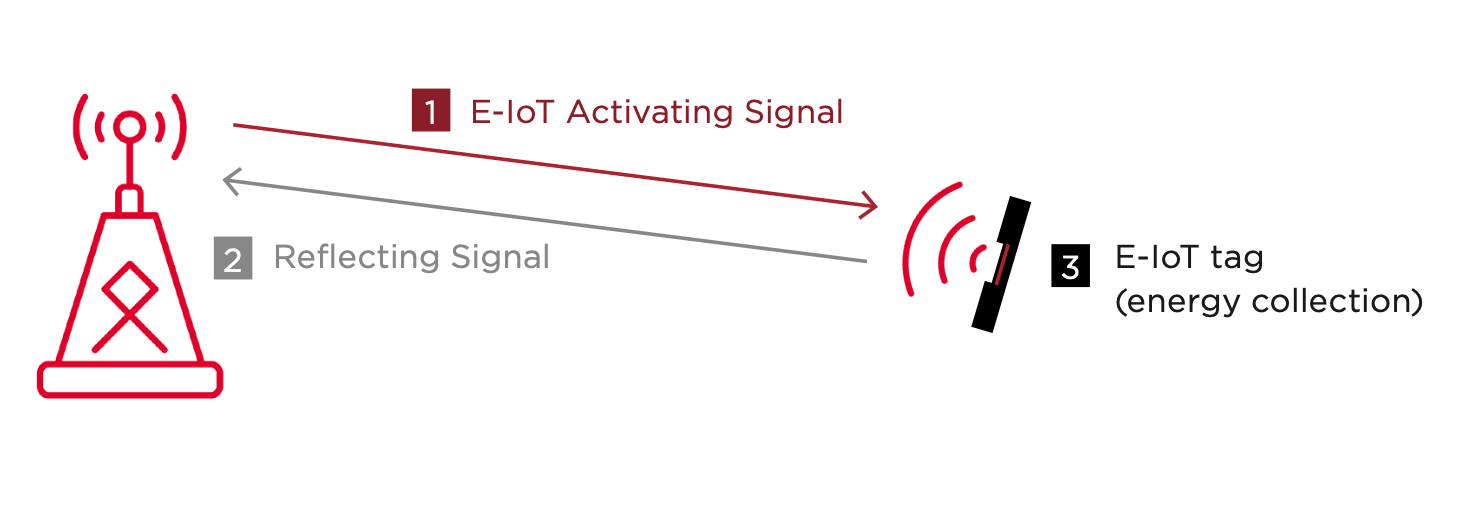5G Transformation Hub
5G Advanced to Support Self-Powered Sensors
Passive IoT tech promises to improve coverage tenfold compared with RFID.
Huawei and China Mobile have conducted field tests of a passive Internet of Things (IoT) solution, which enables large numbers of sensors to transmit data without the need for batteries. Conducted in Chengdu, Sichuan province, China, the tests used a prototype 5G-Advanced network.
Select a project
Contents
Challenge
Traditional sensors require batteries, which are costly to maintain and replace, as well as being detrimental for the environment. Factories, mines, ports, and power plants want to connect large numbers of sensors to track the location and performance of their assets, but are looking for a solution that costs less than 10 U.S. cents and involves power consumption of just 100 uW per device, according to Huawei. While RFID tags are widely used to track inventory today, this wireless technology suffers from a small coverage area and strong self-interference. Huawei says employing RFID solutions is also time-consuming, labour-intensive and inefficient.
Solution
In the second quarter of 2022, Huawei and China Mobile conducted a field test of a passive IoT technology, which obtains energy from the surrounding environment. That means sensors can transmit data without batteries. The technology is designed to be deployed with 5G-Advanced networks, equipped with inter-site resource coordination and joint scheduling optimisation. As well as providing continuous regional coverage, 5G-Advanced networks can employ a simplified air interface to serve ultra-low-cost battery-free terminals.
Impact & Statistics
Huawei say the passive IoT solution it tested improved coverage tenfold compared with RFID. The test, which involved the collection of temperature and humidity data, found that a passive IoT base station supports a maximum reading distance of 235 metres
Wider Implications
Passive IoT technologies could make sensor networks far more economically viable, while dramatically increasing the efficiency of warehouse stocktaking and other industrial processes. The solution could be used to count 100,000 stock items in a warehouse with an accuracy of 99.99%. In the automobile industry, it could track materials across the whole manufacturing process from the workshop to the warehouse, the repacking and sorting area, and the production line. Such tracking to be conducted every hour automatically. In the animal husbandry sector, it could be used for remote automatic stocktaking and real-time temperature and movement monitoring of livestock. It would allow for battery-free sensors to be small and light enough to be worn comfortably by animals.
Stakeholders
Huawei, CMCC (China Mobile Communications Group Co., Ltd.)
02
5G-Advanced to Support Self-Powered Sensors
Extended IoT technology promises to improve coverage tenfold compared with RFID
Industry is going digital: Businesses are increasingly harnessing digital twins to generate a complete and dynamic picture of their assets and their processes. The Internet of Things (IoT) is key to realising this vision. Existing IoT technologies include wide-area connectivity, such as 4G, 5G, and NB-IoT, and local connectivity, such as Wi-Fi, Bluetooth, and LoRa. Although these technologies cover high-speed, medium-speed, and low-speed scenarios, China Mobile Research Institute believes IoT technologies with lower costs, lower power consumption, longer life, wider connections, and easier maintenance are required to achieve the goal of full digitalisation and a target of 100 billion connections.
After more than 80 years of development, RFID technology, which offers low cost and zero power consumption, is widely used in the retail and logistics industries. However, this technology also faces many limitations in application. “Due to problems such as short communication distance, high cost of integrated deployment devices, and low degree of automation, the application scenarios of traditional RFID technology are limited, and technological innovation is required to achieve new breakthroughs,”says Huang Yuhong, General Manager of China Mobile Research Institute.
In the second quarter of 2022, Huawei and China Mobile conducted a field test of so-called extended IoT technology, which obtains energy from the surrounding environ- ment. That means the tags can transmit data without batteries. The technology is designed to be deployed with 5G-Advanced networks, equipped with inter-site resource coordination and joint scheduling optimisation. As well as providing continuous regional coverage, 5G-Advanced networks can employ a simplified air interface to serve very low-cost battery-free terminals. “Extended IoT is the first innovative communications technology that enables terminals to be battery-free,” says John Gao, President of 5.5G Domain, Huawei. “Extended IoT technologies could enable the cellular IoT to expand into new markets, potentially serving a 100 billion connections.” In the field test, the extended IoT solution improved coverage tenfold compared with passive RFID tags, according to China Mobile. The test, which involved the collection of temperature and humidity data, found that an extended IoT base station supports a maximum reading distance of 235 metres. Huawei says the target link budget for extended IoT is 98 dB, compared with downlink maximum coupling loss (MCL) of 58 dB and the uplink MCL of 72 dB for passive RFID.
Furthermore, Huawei says the extended IoT solution consumes power of just 100 uW per device, which is 100 times lower than that of NB-IoT – a low power, wide area cellular technology used for IoT deployments. “It can achieve a true ten-year life cycle with no maintenance issues such as replacing batteries,” adds John Gao. “The cost is about 50 U.S. cents, which is 10~100 times lower than the cost of NB-IoT, and can be widely used in cost-sensitive industries.” Extended IoT connectivity can also pinpoint the location of a device to within two to three meters, while RFID doesn’t support positioning, which makes it difficult to automatically track and locate tags.



John Gao
President of 5.5G Domain, Huawei
03
A wide range of industrial applications
By reducing costs and the need for labour, an extended IoT solution could make sensor networks far more economically viable. Huawei believes extended IoT technologies could support two key IoT application scenarios: Item identification (used for logistics tracking and management of the product lifecycle) and sensors used for collecting key industry information, such as temperature and humidity in the energy industry and animal temperature in the livestock industry.
In the manufacturing sector, extended IoT solutions could be used to greatly reduce the need for paper trails by enabling an automatic inventory system. “An extended IoT solution could, for example, be used to count 100,000 stock items in a warehouse with an accuracy is 99.99%,” says John Gao. Such a solution would save manpower and increase the efficiency of warehouse stocktaking.
“The logistics of goods from the supplier to the factory usually goes through four steps: dock, floor, sorting area, and production line,” explains John Gao. “Currently, a thermal paper needs to be pasted in each link, so that there is a lot of manual participation in the link, and the efficiency is low. Adopting an unique electronic code for goods will greatly reduce manual participation and achieve paper- less and automated turnover.”
In the automobile industry, an extended IoT network could track materials across the whole manufacturing process from the workshop to the warehouse, the repacking and sorting area, and the production line. Such tracking could be conducted every hour automatically.
Extended IoT solutions could also be used in the healthcare sector to monitor the temperature of medicines during cold chain transportation. Other potential wide-area applications include asset management and dangerous goods surveillance. “Global top automotive manufacturers, home appliance manufacturers, and 3C manufacturers are actively promoting industry showcases to explore the maturity of extended IoT in supply chain logistics to achieve paperless strategies,” says John Gao.
Similarly, in the animal husbandry sector, the technology could be used for remote automatic stocktaking and real-time temperature and movement monitoring of livestock. It would allow for battery-free sensors to be small and light enough to be worn comfortably by animals. That would help to accelerate the implementation of precision and smart agriculture. Monitoring animal body temperature and the movement of livestock can, for example, help to detect infections.
In the energy sector, the temperature, humidity and pressure of the power system are key data for predictive maintenance. In many scenarios, however, the collection terminal cannot use batteries because they are too flammable. Yet an extended IoT solution could be used to collect environmental information and the basic data required for predictive maintenance.
Extended IoT could complement other 5G standards being developed by 3GPP, such as conventional NR (New Radio), Redcap (reduced capability) NR and NB-IoT. The goal would be to ensure extended IoT solutions could support continuous local networking and coexist with a standard NR system, through multi-site cooperation and joint scheduling. By taking advantage of the broader cellular network, an extended IoT solution could offer multi-point joint networking to provide seamless read capability in the local area.
Standards body 3GPP intends to define extended IoT in the 5G-Advanced phase, which encompasses 3GPP Release 18 and Release 19. “Extended IoT is being discussed at 3GPP Release 19 and needs to be promoted by multiple parties in the industry,” notes John Gao. “We need to coordinate the development of terminals and networks in advance, plan and develop applications, and provide support for application use.”

04
About
About the GSMA
The GSMA is a global organisation unifying the mobile ecosystem to discover, develop and deliver innovation foundational to positive business environments and societal change. Our vision is to unlock the full power of connectivity so that people,
industry, and society thrive. Representing mobile operators and organisations across the mobile ecosystem and adjacent industries, the GSMA delivers for its members across three broad pillars: Connectivity for Good, Industry Services and Solutions, and Outreach. This activity includes advancing policy, tackling today’s biggest societal challenges, underpinning the technology and interoperability that make mobile work, and providing the world’s largest platform to convene the mobile ecosystem at the MWC and M360 series of events.
For more information, please visit the GSMA corporate website at www.gsma.com.
Follow the GSMA on Twitter: @GSMA.
GSMA 5G Transformation Hub
The GSMA 5G Transformation Hub is a source of information on some of the most innovative 5G solutions in the world. This portal contains case studies detailing design, benefits, key players, measured value and the future impact of scaling up these 5G solutions worldwide. The 5G Era is now firmly established and this family of standardised GSM technologies, including mmWave, are being rolled out successfully across the globe. The GSMA 5G Transformation Hub, launched at MWC Barcelona in 2022, provides details of how 5G is best placed to deliver real value for a range of key sectors including manufacturing, energy, transportation, media and live entertainment, smart cities and construction.. Many more case studies will be added, in the coming months, covering even more industries and the GSMA is asking Members to nominate innovative 5G case studies to add to this global digital showcase. The 5G Transformation Hub and this particular Case Study are both sponsored by Qualcomm.
About this case study
This case study is for information only and is provided as is. The GSM Association makes no representations and gives no warranties or undertakings (express or implied) with respect to the study and does not accept any responsibility for , and hereby disclaims any liability for the accuracy or completeness or timeliness of the information contained in this document. Any use of the study is at the users own risk and the user assumes liability for any third party claims associated with such use.